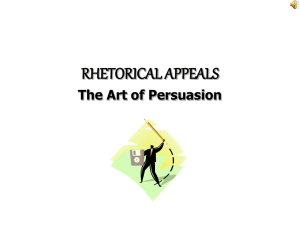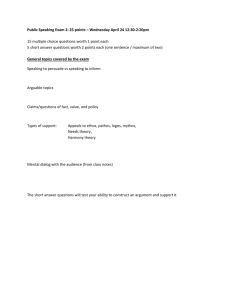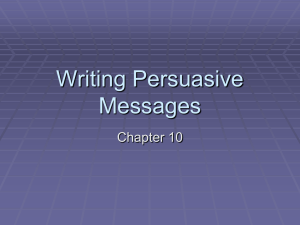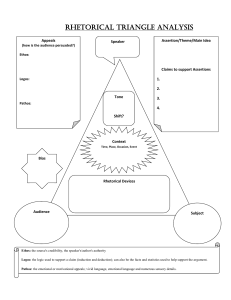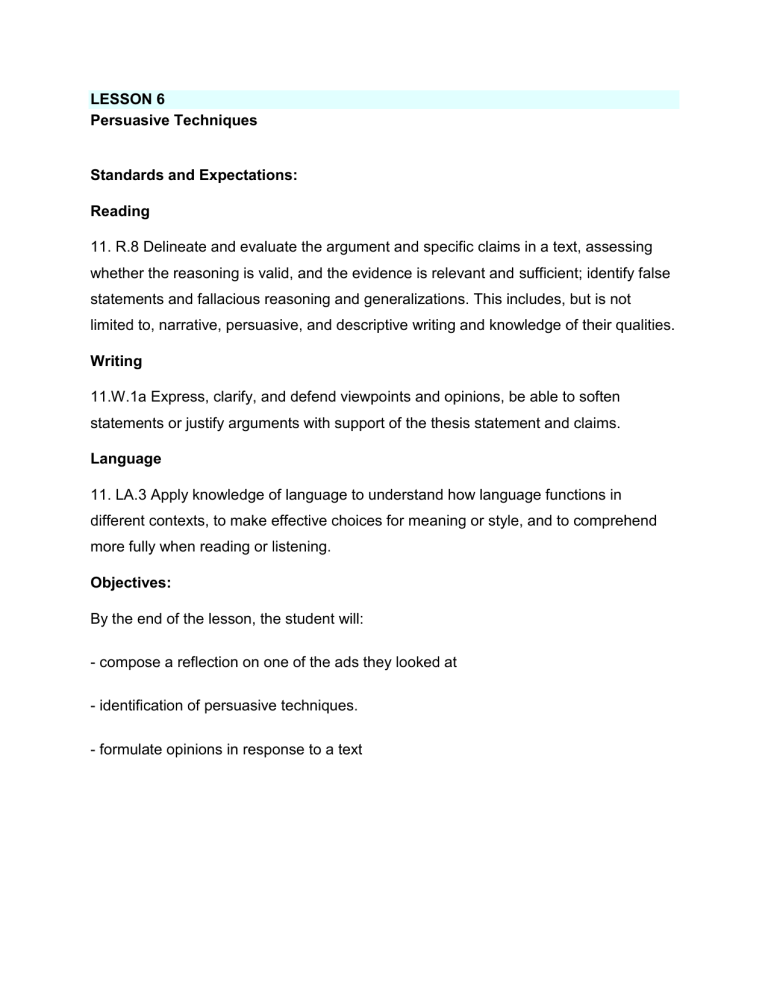
LESSON 6 Persuasive Techniques Standards and Expectations: Reading 11. R.8 Delineate and evaluate the argument and specific claims in a text, assessing whether the reasoning is valid, and the evidence is relevant and sufficient; identify false statements and fallacious reasoning and generalizations. This includes, but is not limited to, narrative, persuasive, and descriptive writing and knowledge of their qualities. Writing 11.W.1a Express, clarify, and defend viewpoints and opinions, be able to soften statements or justify arguments with support of the thesis statement and claims. Language 11. LA.3 Apply knowledge of language to understand how language functions in different contexts, to make effective choices for meaning or style, and to comprehend more fully when reading or listening. Objectives: By the end of the lesson, the student will: - compose a reflection on one of the ads they looked at - identification of persuasive techniques. - formulate opinions in response to a text Introduction Today we will begin learning about the Elements of Persuasion. But first we’re going to study the persuasive techniques. “Persuasion is about convincing the reader or listener to think or act in a certain way.”. What is persuasion? Persuasion is an act or process of presenting arguments to move, motivate, or change your audience. Preview Activity What are persuasive techniques? Persuade Techniques What does it mean to persuade someone? List several methods. 1. ________________________________________________________ 2. ________________________________________________________ 3. ________________________________________________________ 4. ________________________________________________________ Page| 1 Writing Build background Perhaps the first step to understanding persuasion is to recognize the role it plays in our everyday lives. Advertisers attempt to persuade consumers each day using a variety of techniques known as emotional appeals. Review the following information about persuasive techniques. Page| 2 Now let’s ask ourselves Think about advertising you have recently heard, read, or have seen. Reflect about these advertisements that have stuck in your mind. What made these advertisements memorable? _______________________________________________________________________________________ _______________________________________________________________________________________ _______________________________________________________________________________________ _______________________________________________________________________________________ _______________________________________________________________________________________ _______________________________________________________________________________________ Page| 3 Persuasive Technique How it is used? Intended effect Audience buy the Uses the argument that a Bandwagon person should believe or do something because “everybody else” does product because they want to fit in. Audience assume that if others buy it, the product must be good Dishonest tactic in which a salesperson lures Bait and switch customer into a store with the promise of a bargain Audience are persuaded to buy a more expensive item. Audience transfer Celebrity spokesperson Uses a celebrity or famous admiration or respect person to for the celebrity to the endorse a product product Make viewers feel certain Emotional Appeals emotions, such as Viewers transfers that excitement, sadness, or feeling to the product fear Viewers accept this Glittering Generalities Emphasizes highly valued information, often beliefs, such as patriotism, without enough real peace, or freedom. evidence to support the claim. Loaded Language Uses words with positive The words appeal to or negative connotations to consumers’ emotions, describe a product or rather than their reason. Page| 4 that of the competitor— Purr words, such as such as purr, snarl, or “fresh” or “juicy,” make a weasel words product seem more desirable Now let’s look at the following pictures of ads; explain what the ad was attempting to get the viewer to do. How effective was the technique(s)? What was the ad’s strength or weakness? 1. _______________________________________________________________________________ _______________________________________________________________________________ _______________________________________________________________________________ _______________________________________________________________________________ _______________________________________________________________________________ _______________________________________________________________________________ ______________________________________________________________________________ Page| 5 2. _______________________________________________________________________________ _______________________________________________________________________________ _______________________________________________________________________________ _______________________________________________________________________________ _______________________________________________________________________________ _______________________________________________________________________________ ______________________________________________________________________________ Page| 6 3. _______________________________________________________________________________ _______________________________________________________________________________ _______________________________________________________________________________ _______________________________________________________________________________ _______________________________________________________________________________ _______________________________________________________________________________ ______________________________________________________________________________ Page| 7 Reading Comprehension Assessment Directions: Read the passage. Then answer the questions below. Title: Tools of Persuasion (1) Persuasion is the art of convincing someone to agree with your point of view. According to the ancient Greek philosopher Aristotle, there are three basic tools of persuasion: ethos, pathos, and logos. (2) Ethos is a speaker’s way of convincing the audience that she is a credible source. An audience will consider a speaker credible if she seems trustworthy, reliable, and sincere. This can be done in many ways. For example, a speaker can develop ethos by explaining how much experience or education she has in the field. After all, you would be more likely to listen to advice about how to take care of your teeth from a dentist than a firefighter. A speaker can also create ethos by convincing the audience that she is a good person who has their best interests at heart. If an audience cannot trust you, you will not be able to persuade them. (3) Pathos is a speaker’s way of connecting with an audience’s emotions. For example, a speaker who is trying to convince an audience to vote for him might say that he alone can save the country from a terrible war. These words are intended to fill the audience with fear, thus making them want to vote for him. Similarly, a charity organization that helps animals might show an audience pictures of injured dogs and cats. These images are intended to fill the viewers with pity. If the audience feels bad for the animals, they will be more likely to donate money. (4) Logos is the use of facts, information, statistics, or other evidence to make your argument more convincing. An audience will be more likely to believe you if you have data to back up your claims. For example, a commercial for soap Page| 8 might tell you that laboratory tests have shown that their soap kills all 7,000,000 of the bacteria living on your hands right now. This piece of information might make you more likely to buy their brand of soap. Presenting this evidence is much more convincing than simply saying “our soap is the best!” Use of logos can also increase a speaker’s ethos; the more facts a speaker includes in his argument, the more likely you are to think that he is educated and trustworthy. (5) Although ethos, pathos, and logos all have their strengths, they are often most effective when they are used together. Indeed, most speakers use a combination of ethos, pathos, and logos to persuade their audiences. The next time you listen to a speech, watch a commercial, or listen to a friend try to convince you to lend him some money, be on the lookout for these ancient Greek tools of persuasion. 1. As used in paragraph 2, what is the best antonym for credible? a. unintelligent b. boring c. dishonest d. amazing 2. Amy is trying to convince her mother to buy her a pair of $200 shoes. She says: “Mom, the shoes I have are really old and ugly. If I don’t get these new shoes, everyone at school is going to laugh at me. I will be so embarrassed that I will want to die.” What form of persuasion is Amy using here? a. pathos b. ethos c. logos d. a combination of ethos, pathos, and logos Page| 9 3. According to the passage, logos can build ethos because a. an audience is more easily convinced by facts and information than simple appeals to emotions like pity or fear b. an audience is more likely to trust a speaker who uses evidence to support his argument c. a speaker who overuses pathos might make an audience too emotional; audiences who are too frightened or too sad are unlikely to be persuaded d. a speaker can use misleading or false information to make his argument seem more convincing 4. Gareth is running for mayor. He tells his audience: “Under our current mayor, there have been 15,000 new cases of unemployment. If he stays in office, who knows how many more people will lose their jobs? The number could go up even higher. When I was the CEO of Magnatech, I helped to create over 1,000 new jobs. I can do the same thing for this city if you vote for me.” Which form of persuasion is Gareth using here? I. pathos II. logos III. ethos a. I only b. I and II only c. II and III only d. I, II, and III 5. According to the passage, the most effective tool of persuasion is a. ethos, because you cannot persuade an audience that does not trust you b. logos, because it can also be used to build ethos c. a combination of ethos, pathos, and logos d. pathos, because human beings are most easily persuaded by emotion Page| 10 6. Imagine you wanted to convince an uninformed person to take a political position that is the same as yours. What issue would you try to talk to this person about? How would you include ethos, pathos, and logos in your persuasion? Make your case below. ________________________________________________________________ ________________________________________________________________ ________________________________________________________________ ________________________________________________________________ ________________________________________________________________ ________________________________________________________________ ________________________________________________________________ ________________________________________________________________ Language Have you ever wondered what makes you say yes to certain people more willingly than others? Scientists say there’s a science behind the art of persuasion that makes people bend more easily to certain approaches. Renowned Professor Dr. Robert Cialdini came up with the 6 elements of persuasion he believes is behind human behavior. These elements are used by marketers all over the world to direct consumer behaviors and influence the public’s interest. They are also used by politicians, salespeople, and people from different fields, all with varying degrees of success. If you want to have more convincing arguments, whether personal or in business, you need to understand these persuasive principles fully and master them. Page| 11 The six elements are: Reciprocity Scarcity Authority Consistency Liking Consensus Page| 12 Let’s look the closely at the following images: Page| 13 Page| 14 Page| 15 Now, let’s do a practice exercise. For each of the following situations, write your own sentence(s) using persuasive language techniques. Use a different technique for each sentence, and identify the techniques you use: 1. You are trying to convince your friend to join you doing community service hours. ________________________________________________________________ ________________________________________________________________ ________________________________________________________________ Technique(s) used: ______________________________________________ 2. A woman trying to convince her husband to stop eating fast food. ________________________________________________________________ ________________________________________________________________ _______________________________________________________________ Technique(s) used: ______________________________________________ 3. A 12-year-old girl trying to convince her mother to homeschool her. ________________________________________________________________ ________________________________________________________________ _______________________________________________________________ Technique(s) used: ______________________________________________ Page| 16 REFERENCES Boyland, E. J., Harrold, J. A., Kirkham, T. C., & Halford, J. C. (2012). Persuasive techniques used in television advertisements to market foods to UK children. Appetite, 58(2), 658-664. Cialdini, R. B. (2007). Influence: The psychology of persuasion: Robert B. Cialdini. New York: Collins. Page| 17


